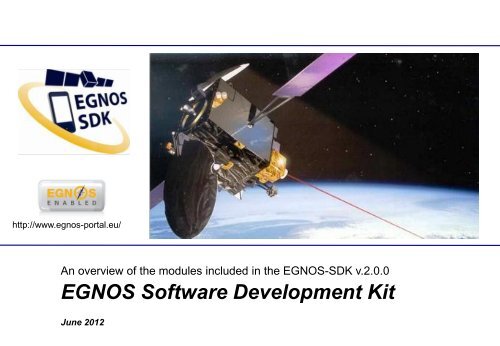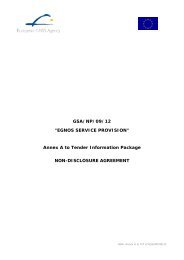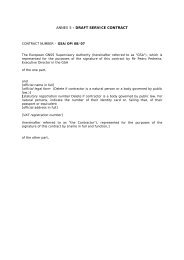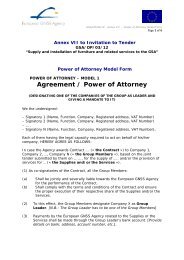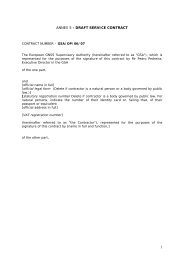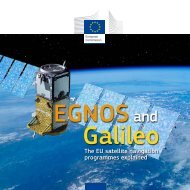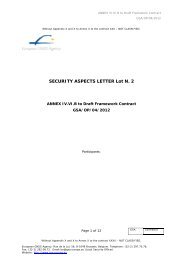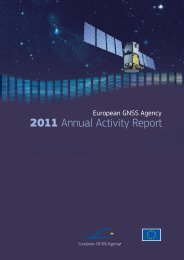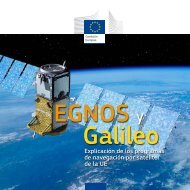EGNOS SDK Development process - EGNOS Portal
EGNOS SDK Development process - EGNOS Portal
EGNOS SDK Development process - EGNOS Portal
Create successful ePaper yourself
Turn your PDF publications into a flip-book with our unique Google optimized e-Paper software.
http://www.egnos-portal.eu/An overview of the modules included in the <strong>EGNOS</strong>-<strong>SDK</strong> v.2.0.0<strong>EGNOS</strong> Software <strong>Development</strong> KitJune 2012
<strong>EGNOS</strong>-<strong>SDK</strong> EnhancementsContentsIntroduction<strong>EGNOS</strong> <strong>SDK</strong> Overview<strong>EGNOS</strong> <strong>SDK</strong> Enhancements Information on satellite origin of the location information• Skyplot view (2D)• Augmented reality skyplot view R&D Algorithms• Increased Satellite Constellation• Best Satellite Constellation• 2D Position Algorithm• Remove RRC• Best Weight Matrix SBAS RangingAlso available: A demonstration applicationshowcasing the capabilities of the<strong>EGNOS</strong> <strong>SDK</strong>http://www.egnos-portal.eu/June 2012 - <strong>EGNOS</strong> Software <strong>Development</strong> Kitpag. 2
<strong>EGNOS</strong>-<strong>SDK</strong> EnhancementsIntroductionThe <strong>EGNOS</strong> <strong>SDK</strong> can be thought of as software GNSS/SBAS receiver applies the full theory of <strong>EGNOS</strong> and GPS starting from the raw data provided by aGNSS chipset to compute a position It is available for a broad set of platforms (iPhone, Android, Blackberry and WindowsPhone) the corrections used come either from the <strong>EGNOS</strong> signal in space or SISNeT A demonstration application provides in real time the GPS position; the <strong>EGNOS</strong>enhanced position and its level of integrity as well as an R&D positionSo far, GPS chips inside smartphones are "blackboxes", the only way to retrieve GPS raw dataneeded to apply <strong>EGNOS</strong> corrections is to rely on an external GNSS receiver connected to thesmartphone by Bluetooth. However, the European Commission is exchanging withsmartphones' manufacturers on ways to get access to GNSS internal chip raw data.June 2012 - <strong>EGNOS</strong> Software <strong>Development</strong> Kitpag. 3
<strong>EGNOS</strong>-<strong>SDK</strong> EnhancementsIntroduction – ToolchainIn order to get the full functionality of the <strong>EGNOS</strong> <strong>SDK</strong> you need the devices* and tools listed:Smartphone (Android, BlackBerry, iPhone or WP7**)An external Bluetooth GNSS/SBAS receiver (uBlox EVK-6T + Bluetooth adapter)<strong>EGNOS</strong>-<strong>SDK</strong>An application to use the <strong>EGNOS</strong>-<strong>SDK</strong> (<strong>EGNOS</strong>-<strong>SDK</strong> demonstration application)* So far, no smartphone provides GPS pseudoranges needed to apply <strong>EGNOS</strong> corrections. An external GNSS receiver is therefore mandatory to demonstrate <strong>EGNOS</strong> capabilities.** Please note that Windows Phone does currently not support Bluetooth functionality; therefore this platform can only use a very limited set of <strong>EGNOS</strong> <strong>SDK</strong> functionalityJune 2012 - <strong>EGNOS</strong> Software <strong>Development</strong> Kitpag. 4
<strong>EGNOS</strong>-<strong>SDK</strong> Overview<strong>EGNOS</strong>-<strong>SDK</strong> MODULESJune 2012 - <strong>EGNOS</strong> Software <strong>Development</strong> Kitpag. 5
<strong>EGNOS</strong>-<strong>SDK</strong>OverviewThe following slides introduce the <strong>EGNOS</strong> <strong>SDK</strong> modules and their interactionThe GPS satellites providethe basic signals required to compute a positionSISNeT provides the sameinformation as the <strong>EGNOS</strong>satellites through the Internet GPS satellitesThe <strong>EGNOS</strong> satellites providethe correction signals to enhancethe GPS position <strong>EGNOS</strong> satellitesSISNeT serverThe external receiver obtainsall the information from thesatellites and forwards it to theBluetooth module External GNSS/SBASreceiver e.g. uBlox-EVK-6TThe Bluetooth moduletransmits the data from thereceiver to the smartphone RS-232 genderchangerBluetooth adaptere.g. BlueSerialThe smartphone runs the<strong>EGNOS</strong> <strong>SDK</strong>, whichcomputes the position withthe raw data from the external receiverSmartphoneJune 2012 - <strong>EGNOS</strong> Software <strong>Development</strong> Kitpag. 6
INPUT<strong>EGNOS</strong>-<strong>SDK</strong>Overview / StructureSmartphone SensorsGPS satellitesSISNeT server<strong>EGNOS</strong> satellites<strong>EGNOS</strong>-<strong>SDK</strong> v.2.0<strong>EGNOS</strong>-<strong>SDK</strong> v.1.0<strong>EGNOS</strong>RangingSatelliteReceiverspecificsEgnosLong correctionAugmentedReality ViewSISNeTConstantsTroposphereSkyplot ViewPositionningMatrixIonosphereDemonstrationapplicationR&DAlgorithmsEphemerisUtilsFast correction<strong>EGNOS</strong> enhanced position(increased robustness, accuracyand reliability)GPS Position<strong>EGNOS</strong> position(increased accuracy and integrity)OUTPUTJune 2012 - <strong>EGNOS</strong> Software <strong>Development</strong> Kitpag. 7
<strong>EGNOS</strong>-<strong>SDK</strong>Module interactionServerReceiverEgnosSISNeTReceiverspecificsLong-Corr.EphemerisFast-Corr.SatelliteIonosphereTropospherePositioningPositioning R&DEnhanced <strong>EGNOS</strong> and R&D Position (φ λ һ)June 2012 - <strong>EGNOS</strong> Software <strong>Development</strong> Kitpag. 8
Max. exceeded – exit, no position<strong>EGNOS</strong>-<strong>SDK</strong>Module interaction - PositioningPositioningx i , y i , z iSatellite positionRange determinationR i = x i − x u 2 + y i − y u 2 + z i − z u2Initial position (Bancroft)Definition of the matrixH = − cos el i sin az i − cos el i cos az i − sin el i 1pr iPseudorangesApply <strong>EGNOS</strong> CorrectionsPR i = PR i + Fast Corr. + Iono. Corr. + Tropo. Corrt iSatellite clock biasRange differencedPR i = pr i +c. t i + IC i + TC i + PRC i − R iCorrected pseudrangedX = (H T . H) −1 . H T . dPRWWeight matrixSolvedX = (H T . W. H) −1 . H T . W. dPRCheck iterationsUpdate positionsX = X + dXCheck HDOPCheck updateStop|r n−1 − r n | < εr = x u ² + y u ² + z u ²… shows the influence of <strong>EGNOS</strong>June 2012 - <strong>EGNOS</strong> Software <strong>Development</strong> Kitpag. 9
Max. exceeded – exit, no position<strong>EGNOS</strong>-<strong>SDK</strong>Module interaction - R&D PositioningF5. SBAS RangingSatellite positionInitial position (Bancroft)F3.Improve Sat. Const.PositioningRange determinationDefinition of the matrixR i = x i − x u 2 + y i − y u 2 + z i − z u2H = − cos el i sin az i − cos el i cos az i − sin el i 1PseudorangesF3. Fast Corr. with No RRCApply <strong>EGNOS</strong> CorrectionsPR i = PR i + Fast Corr. + Iono. Corr. + Tropo. Corrt iSatellite clock biasRange differencedPR i = pr i +c. t i + IC i + TC i + PRC i − R iCorrected pseudrangeF3. Best Weight MatrixWWeight matrixSolvedX = (H T . H) −1 . H T . dPRdX = (H T . W. H) −1 . H T . W. dPRCheck iterationsF3. Best Sat. Const.Update positionsX = X + dXCheck HDOPCheck updateStop|r n−1 − r n | < εr = x u ² + y u ² + z u ²… shows the influence of <strong>EGNOS</strong>June 2012 - <strong>EGNOS</strong> Software <strong>Development</strong> Kitpag. 10
Introduction to the high-level functionality of the <strong>EGNOS</strong>-<strong>SDK</strong> v.2.0.<strong>EGNOS</strong>-<strong>SDK</strong> ENHANCEMENTSJune 2012 - <strong>EGNOS</strong> Software <strong>Development</strong> Kitpag. 11
<strong>EGNOS</strong>-<strong>SDK</strong> EnhancementsInformation on satellite origin of the location informationPurpose: provide the user information about the position of the GPS and <strong>EGNOS</strong>satellites overhead of the observer with a time span of +12h or -12h.This functionality also provides an “augmented reality” feature, which shows a live-videostream of the sky displaying the satellites in view in whichever direction the smartphoneis pointed.The “Skyplot” featureThe view encompasses a skyplot that displays the current position of the GPS/<strong>EGNOS</strong>satellites.A historic path is drawn to indicate the path the satellite has taken. This view will containa time slider with an observation time range from -12h to +12h. On moving the timeslider, the position of the GPS/<strong>EGNOS</strong> satellites will move based on the observationtime.Information about the number of satellites related to the current location is provided: the <strong>EGNOS</strong> satellites in red (<strong>EGNOS</strong>) the GPS satellites used for a GPS only PVT computation in blue (GPS) the GPS satellites used for the <strong>EGNOS</strong> PVT computation in green (Total) the GPS satellites in view but not used in grey (Not used)June 2012 - <strong>EGNOS</strong> Software <strong>Development</strong> Kitpag. 12
<strong>EGNOS</strong>-<strong>SDK</strong> EnhancementsInformation on satellite origin of the location informationAdvanced Skyplot featurea screen will display the live-video stream of the sky as shown in the figure. This view willdisplay the current position of the GPS/<strong>EGNOS</strong> satellite/s to where the mobile device ispointed at.The type of satellites displayed in this view is based on the type of satellitesenabled/disabled in the normal skyplot view.On tapping a satellite, a popup would be displayed giving information about the satellite (PRN, Name of the satellite, SNR, Elevation)The historic (in grey) and future path of the GPS satellites in the same color as the satellite“Advanced Skyplot about” icon (bottom most right corner)Satellite with future and historic path Information box for satellite “About” icon Horizon; vertical line indicatingthe center of the screenJune 2012 - <strong>EGNOS</strong> Software <strong>Development</strong> Kitpag. 13
<strong>EGNOS</strong>-<strong>SDK</strong> EnhancementsInformation on satellite origin of the location informationThe live-video screen will contain the following: The horizon (represented as a line) The geographic direction (top most right corner) An arrow pointing to the direction at which an <strong>EGNOS</strong> satellite is available, also atext below the arrow indicating the distance in percentage remaining to view the<strong>EGNOS</strong> satellite; (0% closest / 100% furthest). Geographic direction of thedeviceDistance in percentageremaining to view the <strong>EGNOS</strong> satellite Arrow indicating the directionin which an <strong>EGNOS</strong> satelliteis availableJune 2012 - <strong>EGNOS</strong> Software <strong>Development</strong> Kitpag. 14
<strong>EGNOS</strong>-<strong>SDK</strong> EnhancementsInformation on satellite origin of the location informationImplementation Details (Skyplot Feature)Based on the azimuth and the elevation information obtained from NORAD TLE (TwoLine Element Set) data the satellites are shown on the skyplot.The position of the satellite for a time in the past or future would be obtained byrequesting data from NORAD and determine current azimuth and elevation based on thisdata.Satellite information displayed: The number of GPS satellites used in GPS PVT, obtained by checking all thesatellites in view that have an elevation angle above ten degrees. The number of SBAS satellites in view The number of GPS satellites used in <strong>EGNOS</strong> PVT, obtained by checking all thesatellites in view that have an elevation angle above ten degrees and also thesatellites PRNs must be in the PRN mask and their UDREs have to be less than 14 Total number of satellites, indicating the number of GPS satellites in view The number of satellites not used, is obtained by getting all the satellites with anelevation less than ten degreesJune 2012 - <strong>EGNOS</strong> Software <strong>Development</strong> Kitpag. 15
<strong>EGNOS</strong>-<strong>SDK</strong> EnhancementsInformation on satellite origin of the location informationImplementation Details (Advanced Skyplot Feature)Information required: The Azimuth providing the direction at which the mobile device is pointed The elevation providing the smartphones screen angle relative to the horizon The azimuth and the elevation of the satellitesThe azimuth and elevation of device is converted to screen coordinates using thehorizontal and vertical angle of view of camera.The azimuth and elevation of satellites is converted to screen coordinates based on thecombination of the screen width and height and the screen coordinates of the azimuthand elevation of device. If the screen coordinates of the satellites are valid then thesatellite image is drawn on the screen. Due to computational requirements, the approachmight suffer modifications.The advanced skyplot view will also display the horizon, the geographic directions,arrows pointing to the <strong>EGNOS</strong> satellites and the historic path of the GPS satellites.June 2012 - <strong>EGNOS</strong> Software <strong>Development</strong> Kitpag. 16
<strong>EGNOS</strong> <strong>SDK</strong> v2R&D ALGORITHMSJune 2012 - <strong>EGNOS</strong> Software <strong>Development</strong> Kitpag. 17
<strong>EGNOS</strong>-<strong>SDK</strong> EnhancementsR&D AlgorithmsThe R&D features of the <strong>EGNOS</strong> <strong>SDK</strong> are intended toprovide more robustness, accuracy and reliability on thepositionEach of this algorithms can be activated separatelyIt is important to understand that the R&D features donot comply with the DO-229 specification and thereforethe R&D position shown does not provide integrityA special case of the R&D features is the SBAS ranging;Please note that this feature can cause an error in theposition accuracy since <strong>EGNOS</strong> contrary to WAAS doesnot offer currently a ranging capability.June 2012 - <strong>EGNOS</strong> Software <strong>Development</strong> Kitpag. 18
<strong>EGNOS</strong>-<strong>SDK</strong> EnhancementsR&D AlgorithmsR&D Algorithms Means ImprovementIncreased SatelliteConstellationBest Satellite Constellation2D Position AlgorithmRemove RRCBest Weight MatrixSBAS RangingIncrease the number of satellitesincluded in the positioncomputation.Select the best satellite geometryto be used in the positioncomputation based on DOP.Reduce the number of unknowns inthe position computation algorithm.Compute fast corrections withoutthe addition of RRC.Apply the most beneficial weightmatrix for the least squaresprocedure.Include the SBAS satellites in theposition computation.Increased reliability andredundancy.Maximize the position accuracyavailable.Increased availability.Apply most suitable satelliteclock and ephemeriscorrections.Maximize performance results.Increased system availabilityand reliability.June 2012 - <strong>EGNOS</strong> Software <strong>Development</strong> Kitpag. 19
<strong>EGNOS</strong>-<strong>SDK</strong> EnhancementsR&D Algorithms: Increased Satellite ConstellationPurpose: Improve the uncertainty of the PVT solution by increasing the number ofobservations, or satellite signals used. An increased number of satellites used in theposition computation could lead to an improvement in the position accuracy.Reasons satellites are excluded from the position computation: Low elevation angle Low Signal-to-Noise Ratio (SNR) “Not Monitored <strong>EGNOS</strong> Indicatorunreliable range measurementsdesigned for aviation applications tomeet integrity requirementsAviation ApplicationsIntegrity requirementClear view of the skySmartphone ApplicationsAvailability requirementObstructed view of satellitesTherefore, the requirements mentioned in the DO-229D specification have to be adaptedfrom the aviation sector to the urban scenarios, targeting smart-phone applications,where the number of satellites available is reduced in comparison to aviationapplications, and where integrity is not a top priority.June 2012 - <strong>EGNOS</strong> Software <strong>Development</strong> Kitpag. 20
<strong>EGNOS</strong>-<strong>SDK</strong> EnhancementsR&D Algorithms: Increased Satellite ConstellationThe position accuracy can be improved by introducing in the computations the satellites that normally are eliminated due to thespecification requirements ( include satellites flagged as “Not Monitored”). applying ionospheric corrections to satellites which have no ionospheric correctionprovided by <strong>EGNOS</strong> due to unmonitored IGPsFor the cases where ionospheric corrections cannot be computed due to unmonitoredIGPs, the ionospheric correction is computed by means of the Klobuchar ionosphericmodel and ionospheric coefficients broadcasted in the GPS navigation messages.Outcome: Ionospheric corrections will be available independent of the availability of the<strong>EGNOS</strong> system Ionospheric corrections can be applied before and until the <strong>EGNOS</strong> messages havebeen acquired and decoded All satellites will be corrected for at least:• Ionospheric Errors• Tropospheric ErrorsJune 2012 - <strong>EGNOS</strong> Software <strong>Development</strong> Kitpag. 21
<strong>EGNOS</strong>-<strong>SDK</strong> EnhancementsR&D Algorithms: Increased Satellite ConstellationThe Klobuchar model provides: Ionospheric corrections based on the ionospheric coefficients provided in the GPSmessage (subframe 4) Simplicity of the algorithm Low computation time 50-60% ionospheric delay correction Inaccurate representation in the near equatorial region of the world The algorithm is very poor in high latitude regions The model is unable to represent the behavior of the ionosphere when rapidchanges occur The model is built on a simple cosine representation of the ionospheric delay, with afixed phase-zero at 14:00 local time and a constant night time offset of 5nanoseconds.Source: http://iri2011.hmo.ac.za/IRIpresent/Wednesday/Vemuri_IRI%202011.pdfJune 2012 - <strong>EGNOS</strong> Software <strong>Development</strong> Kitpag. 22
<strong>EGNOS</strong>-<strong>SDK</strong> EnhancementsR&D Algorithms: Increased Satellite ConstellationThe purpose of the Klobuchar model is not to replace <strong>EGNOS</strong> ionospheric corrections,but to assist in those cases where <strong>EGNOS</strong> corrections are not available for one reasonor the other: The satellite signal passes an area “Not Monitored” by <strong>EGNOS</strong> Ionospheric correction set to “Don’t Use” <strong>EGNOS</strong> ionospheric correction messages not yet fully received Reception of the <strong>EGNOS</strong> signal is obstructedJune 2012 - <strong>EGNOS</strong> Software <strong>Development</strong> Kitpag. 23
<strong>EGNOS</strong>-<strong>SDK</strong> EnhancementsR&D Algorithms: Best Satellite ConstellationPurpose: Relate the quality of the GPS satellite geometry to the accuracy of positionobtained.Dilution of Precision (DOP) is the ratio of the standard deviation of errors in the leastsquaressolution to the standard deviation of the measurement errors.The idea of Geometric DOP is to state how errors in the measurement will affect the finalstate estimation. The DOP parameters are defined as geometry factors that relateparameters of the user position and time bias errors to those of the pseudorange errors.The Geometry Dilution of Precision (GDOP) can be defined as: GDOP = ∆OutputLocation∆MeasuredDataNeglecting ionospheric and tropospheric effects, the signal from GPS satellites has afixed precision. Therefore, the relative satellite-receiver geometry plays a major role indetermining the precision of estimated positions and times.The computations can be done using a selection of the satellites that provides the bestDOP. Therefore the aim is to choose the satellite set that minimizes the DOP.Multiplying the User Equivalent Range Error (UERE) – the root-sum-square of thevarious errors and biases involved - by the DOP produces the expected precision of theGPS position at 1-sigma (1-σ) level.June 2012 - <strong>EGNOS</strong> Software <strong>Development</strong> Kitpag. 24
<strong>EGNOS</strong>-<strong>SDK</strong> EnhancementsR&D Algorithms: Best Satellite ConstellationIn order to obtain a good satellite geometry, the volume of the square pyramid formed bylines joining four satellites with the receiver at the tip of the pyramid has to be maximized.Having this aspect in mind, the largest volume can be obtained by using PRN 7, 19, 21and 22 respectively.June 2012 - <strong>EGNOS</strong> Software <strong>Development</strong> Kitpag. 25
<strong>EGNOS</strong>-<strong>SDK</strong> EnhancementsR&D Algorithms: 2D Position AlgorithmPurpose: provide a position result when only a reduced set of satellites is available.The standard GPS Algorithm has four unknowns: Latitude Longitude Altitude TimeGPSGPSBy eliminating one of the unknowns:• Latitude• Longitude• Altitude• Time Three satellites are sufficient to obtain a position, which is an important aspect inurban situations, where surrounding buildings obstruct the clear view of the sky,many times making it difficult to track four satellites. The ratio of number of observations available to the number of unknowns increasesand as a result a solution with a lower degree of uncertainty can be obtainedJune 2012 - <strong>EGNOS</strong> Software <strong>Development</strong> Kitpag. 26
<strong>EGNOS</strong>-<strong>SDK</strong> EnhancementsR&D Algorithms: 2D Position AlgorithmReasons for eliminating the altitude from the list of unknowns: most of the applications, especially the ones designed for the smart-phone usage,focus on latitude and longitude rather than on elevation. the altitude is the least varying parameter in land applications (especially in urbancases). altitude can be determined through other means, for instance sensors can be usedto augment the position.GPS computations can be performed to determine the altitude as long as more thanthree satellites are available. Once the number of satellites is reduced a barometer (orthree-axis accelerometer) can determine any change in altitude, and correct itaccordingly. This could be the case when the user is situated in an urban location.The accuracy of the GPS unit in 2D mode is greatly affected by the change in elevationsince the last 3D point. For example, on terrains with little change in altitude, the 2Dposition accuracy would not be affected as much as it would be in areas where thealtitude would change considerably. Larger elevation changes cause the GPS positioncomputation to be less accurate in 2D mode.June 2012 - <strong>EGNOS</strong> Software <strong>Development</strong> Kitpag. 27
<strong>EGNOS</strong>-<strong>SDK</strong> EnhancementsR&D Algorithms: 2D Position AlgorithmApproaches to Three Satellites Algorithm 3D position fix• The altitude information obtained while computing a 3D position is stored for possible future use in the 2Dposition fix 2D position fix• The altitude information is obtained from previous 3D position computations, or from the smartphonesensorsStartNo position availableNoNumber of Sat = 3NoNumber of Sat > 4YesCompute 3D positionYesNoAltitude availableStore altitudeYesCompute 2D positionOutput positionJune 2012 - <strong>EGNOS</strong> Software <strong>Development</strong> Kitpag. 28
<strong>EGNOS</strong>-<strong>SDK</strong> EnhancementsR&D Algorithms: Remove RRCPurpose: determine if by eliminating the RRC from the computation of the fast correctionsthat are applied to the pseudorange (PR) measurements, the results of the positioningwill improve.The SBAS data does not include range rate corrections. These are generated within theuser equipment itself by differencing successive clock corrections.RRC is used to interpolate correction values in future using previously receivedpseudorange correction (PRC) values.PR corrected = PR + PRC current + RRC ∗ (t − t of,current )June 2012 - <strong>EGNOS</strong> Software <strong>Development</strong> Kitpag. 29
<strong>EGNOS</strong>-<strong>SDK</strong> EnhancementsR&D Algorithms: Remove RRCThe concept is exemplified in the graph below (simulated data).The value of the RRC grows with every passing second for which there is no fastcorrection provided. For two sequential corrections with a difference of 0.5 meters,received four seconds apart (very common behavior), after one second, the value of theRRC will be 0.5/4 * 1= 0.125, 0.25 after two seconds, and so on, growing with everysecond.June 2012 - <strong>EGNOS</strong> Software <strong>Development</strong> Kitpag. 30
<strong>EGNOS</strong>-<strong>SDK</strong> EnhancementsR&D Algorithms: Remove RRCReal data results:June 2012 - <strong>EGNOS</strong> Software <strong>Development</strong> Kitpag. 31
<strong>EGNOS</strong> <strong>SDK</strong> v2 - R&D AlgorithmsSBAS RANGING** Please note that this feature can cause an error in the position accuracy since <strong>EGNOS</strong> contrary to WAAS doesnot offer currently a ranging capability.June 2012 - <strong>EGNOS</strong> Software <strong>Development</strong> Kitpag. 32
<strong>EGNOS</strong>-<strong>SDK</strong> EnhancementsR&D Algorithms: SBAS RangingPurpose: enable SBAS geostationary satellites to be used for ranging in the same wayGPS satellites are used to obtain a position, which offers an increased availability of thesystem due to an increased number of satellites, together with a possible increase in thequality of the satellite geometry which can reflect in a better position accuracy.MT9, the GEO Navigation Message, provides precise orbit information for the GEOsatellites and it is intended to be used in the position computation, similar as the GPSephemeris data is used.MT17 – the GEO Satellite Almanac Message which contains the rough location of thesatellite is used with the purpose of speeding up the acquisition having known the roughposition of the satellites.MT17 will also be used to determine in the Automatic Mode of the Ranging Functionality,if the data provided in MT9 can be used for ranging or it is provided only for testingpurposes.As opposed to GPS satellites ephemeris, instead of Keplerian elements, the ephemerisdata of the SBAS satellites consist of the Earth-Centered-Earth-Fixed (ECEF) positioncoordinates, satellite velocity and satellite acceleration.The simplification of the model for SBAS satellite positions is due to the fact that theSBAS satellites are geostationary satellites, so the change in position with respect totheir nominal position should be very small.June 2012 - <strong>EGNOS</strong> Software <strong>Development</strong> Kitpag. 33
<strong>EGNOS</strong>-<strong>SDK</strong> EnhancementsR&D Algorithms: SBAS RangingThe position computation algorithm:Troposperic modelFast correctionsMT2-5, MT24GPS pseudorangesLong correctionsMT24, MT25GPS ephemeris dataGet correctedpseudorangesIonosphericcorrections MT18,MT26<strong>EGNOS</strong> correctedpseudorangesGPS satellite positionENT/UTC offset MT12Compute positionPrecise GEOsatellite positionGEO navigationmessage MT9June 2012 - <strong>EGNOS</strong> Software <strong>Development</strong> Kitpag. 34


